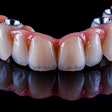
The number of dentists per capita in the U.S. is projected to rise by about 10% over the next 20 years as the number of new dentists entering practice outstrips slowing population growth, according to a research brief published on May 13 by the ADA Health Policy Institute (HPI).
The per capita supply of dentists is projected to grow significantly through 2040 even after adjusting for anticipated changes in the hours they work due to the age and gender of clinicians, the authors wrote.
"Total inflows to the dentist workforce are expected to exceed total outflows, and this net gain is expected to outpace the projected growth of the U.S. population," wrote the authors, led by Marko Vujicic, PhD, HPI's chief economist and vice president.
Meeting dental care needs
Having an adequate number and distribution of dental providers is vital to ensuring people have access to care. Currently, there is a shortage of about 11,000 dentists in the U.S., according to the Health Resources and Services Administration, an agency of the U.S. Department of Health and Human Services. In recent years, several dental schools have opened to help grow the dentist workforce.
However, the number of dentists alone does not address adequacy concerns. Numerous factors, including the population's demand for dental care and the mix of patients in terms of payer type and where they live, determine whether the number of dentists is ample.
Nevertheless, the need for dental care in specific geographic areas of the U.S. and among disadvantaged populations may result in an insufficient number of dentists.
To make their dental supply projections, researchers analyzed data from the U.S. Census Bureau and the National Bureau of Economic Research, as well as the ADA masterfile, a database of annual archived datasets from 2002 through 2020 that comprises historical data about dentists, including age, dental school graduation year, licensure status, practice location, and retirement date.
Researchers also reviewed data from the ADA's Survey of Dental Education, which provides information about graduates and current dental school enrollment, and the ADA's Survey of Dental Practice, which provides insight into the variations of dentists' working hours and the number of patients they visit, according to the brief.
Researchers' projections were made using the most probable assumptions based on the following information:
- Population growth in the U.S. will stay close to its recent comparatively low levels.
- The annual number of U.S. dental school graduates will increase through 2026 and then remain constant.
- Over the next five years, the retirement rate for dentists will increase at the same rate seen in recent years.
A surplus of dentists
In 2020, there were approximately 201,000 practicing dentists in the U.S, which translates to 61 dentists per 100,000 people. That number is expected to climb by 10.4% to 67 dentists per capita in 2040, according to the findings.
The data show that the dental workforce throughout the next couple of decades is expected to comprise an equal number of men and women. Annually, on average, women work fewer hours than men. Additionally, on average, both female and male dentists reduce the number of hours they work as they age. After adjusting for the anticipated shifts in hours worked for the workforce, the growth rate of dentists is 9.7%, the authors wrote.
Interpret with caution
Because HPI's dental workforce projection model has the potential to generate multiple scenarios based on different assumptions, the data must be explicated carefully. Knowing how the total number of dentists may evolve only partially contributes to the question of whether there will be a shortage of dentists in the coming years.
The future demand for dental care among the population, the evolution of dentists' productivity and efficiency, and potential changes in oral care delivery models, ultimately, will affect the demand for dentists. Therefore, the issue of provider adequacy requires additional research in the future, the authors wrote.
Nevertheless, "the per capita supply of dentists in the United States is projected to increase through 2040," Vujicic and his colleague wrote.




















